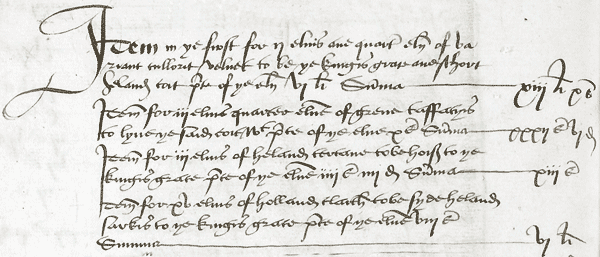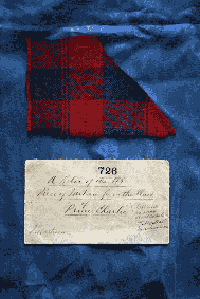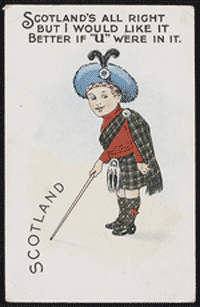| Sign Up to the Register | While you can search the Register without having to register and login, you will need to create an account to: | - | Register new tartan designs | | - | Request threadcount information | | - | Receive notification of all new registered tartan designs and other news updates | | - | Manage your account details | | - | Request official amendments | | | | | |  | | |  |
|
| | |
|
|
Sources in the National Records of Scotland
The National Records of Scotland (NRS) looks after the records created by Scottish kings and queens, businesses, families, churches and the courts which make up the written history of Scotland. Amongst these medieval charters, wills, letters, diaries, records of crime, photographs, maps and plans, there are interesting sources for tartan history. A few of these sources are featured on this page.
The earliest mention of
'Highland tartan', 1538
Early tartan manufacture,
1734-37
Bonnie Prince Charlie's plaid,
1746
Poverty and Tartan, 1747
Swatches of cloth for military
uniform, 1746
King George IV visits Scotland,
1822
Comic postcard, 1920
The earliest mention of 'Highland tartan', 1538

The image shows the entry in the Exchequer records for the earliest mention of Highland tartan, 1538 (NRS reference: E21/34)
The words 'Heland tartane' occur in an account for clothes for King James V in 1538. The word 'Highland' is used to describe this tartan which suggests a chequered pattern that we would recognise as tartan, worn as hose (tight-fitting trousers/tights). The entry for 'heland tartane' reads:
Scots transcript:
ITEM in the first for ij elnis ane quart[er] eln[e] of va-
riant cullorit veluet to be the Kingis grace ane schort
heland coit p[re]ce of the eln[e] vj li~ Su[m]ma xiij li~ x d~
Item for iij elnis quarter elne of grene taffatyis
to lyne the said coit w[i]t[h] p[re]ce of the elne x s~ Su[m]ma xxxij s~ vj d~
Item for iij elnis of heland tertane to be hoiss to the
kingis grace p[re]ce of the elne iiij s~ iiij d~ Su[m]ma xiij s~
Item for xv elnis of Holland claith to be syde heland
sarkis to the kingis grace p[re]ce of the elne viij s~
Summa vj li~
Notes: An ell was a measurement of length.
[Back to top
]
Early tartan manufacture, 1734-37
The Spinning book of the Orphan Hospital Manufactory and Paul's Work, Edinburgh (part of the records of the Dean Orphanage and Cauvin's Trust), contains a record of wool spun and given out for spinning, as well as a brief record of tartans supplied in 1751-2. At the front of the volume there is a note 'of the different colours in the 48 yard tartan no. first' and 'no. 2nd', warp and weft'.
(NRS reference: GD417/262)
[Back to top]
Bonnie Prince Charlie's plaid, 1746
 |
The image shows a piece of Bonnie Prince Charlie's plaid, 1746 (NRS reference: RH19/36/2)
A piece of tartan, believed to be from the plaid of Bonnie Prince Charlie, given to Lady Mackintosh at Moy Hall, Inverness-shire, where he rested before the Battle of Culloden in April 1746. Tests have been carried out on the dyes, which suggest the tartan is of the correct period.
(NRS reference: RH19/36/2)
|
|
[Back to top]
Swatches of cloth for military uniform, 1746
Five swatches of cloth for military uniforms sent by David Stewart in Edinburgh on the 25 September 1746. Their owner in 1867 noted on the back that they were 'very fresh yet'.
(NRS reference: GD128/Box 38/Bundle 4)
[Back to top]
Poverty and Tartan, 1747
On 1 August 1747 Hugh Forbes wrote a letter concerning the plight of three shearers, imprisoned by the magistrates of Musselburgh: 'by all the information I could procure their only Crimes (are) Poverty and Tartan, which too often Appear coupled'. He urges his correspondent not to allow the shearers to die of hunger now that their 3d (pence) a day allowance has been withdrawn.
(NRS reference: RH15/38/105)
[Back to top]
King George IV visits Scotland, 1822
King George IV visited Scotland in 1822. During his visit, the King wore Highland dress to many formal events and, because the King was wearing tartan, everyone else needed to wear it too. Mrs Harriet Scott, who was in Edinburgh at the time, wrote to her daughter, Anne, describing King George IV in Highland Dress 'with Buff coloured trousers like flesh to imitate his Royal Knees, and little Tartan bits of stockings like other Highlanders half up his Legs, he looked very well, only a little huffle buffle by all accounts. He is to have a still finer Highland Dress for the Drawing room his Royal Knees are to be covered with Tartan so as not to look like Flesh'.
(NRS reference: GD157/2548/3)
[Back to top]
Comic postcard, 1920

|
Comic postcard showing a boy in Highland Dress, 1920 (NRS reference: GD1/1295/5) p>Tartan and Highland dress are well known symbols of Scotland and the Scots, and they have been widely used in advertising since the nineteenth century. This postcard dates from the 1920s.
(NRS reference: GD1/1295/5)
|
|
[Back to top]
|